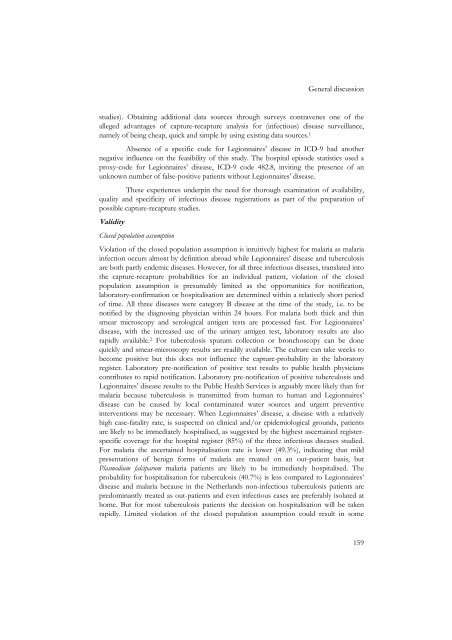Rob van Hest Capture-recapture Methods in Surveillance - RePub ...
Rob van Hest Capture-recapture Methods in Surveillance - RePub ...
Rob van Hest Capture-recapture Methods in Surveillance - RePub ...
Create successful ePaper yourself
Turn your PDF publications into a flip-book with our unique Google optimized e-Paper software.
General discussion<br />
studies). Obta<strong>in</strong><strong>in</strong>g additional data sources through surveys contravenes one of the<br />
alleged ad<strong>van</strong>tages of capture-<strong>recapture</strong> analysis for (<strong>in</strong>fectious) disease surveillance,<br />
namely of be<strong>in</strong>g cheap, quick and simple by us<strong>in</strong>g exist<strong>in</strong>g data sources. 1<br />
Absence of a specific code for Legionnaires’ disease <strong>in</strong> ICD-9 had another<br />
negative <strong>in</strong>fluence on the feasibility of this study. The hospital episode statistics used a<br />
proxy-code for Legionnaires’ disease, ICD-9 code 482.8, <strong>in</strong>vit<strong>in</strong>g the presence of an<br />
unknown number of false-positive patients without Legionnaires’ disease.<br />
These experiences underp<strong>in</strong> the need for thorough exam<strong>in</strong>ation of availability,<br />
quality and specificity of <strong>in</strong>fectious disease registrations as part of the preparation of<br />
possible capture-<strong>recapture</strong> studies.<br />
Validity<br />
Closed population assumption<br />
Violation of the closed population assumption is <strong>in</strong>tuitively highest for malaria as malaria<br />
<strong>in</strong>fection occurs almost by def<strong>in</strong>ition abroad while Legionnaires’ disease and tuberculosis<br />
are both partly endemic diseases. However, for all three <strong>in</strong>fectious diseases, translated <strong>in</strong>to<br />
the capture-<strong>recapture</strong> probabilities for an <strong>in</strong>dividual patient, violation of the closed<br />
population assumption is presumably limited as the opportunities for notification,<br />
laboratory-confirmation or hospitalisation are determ<strong>in</strong>ed with<strong>in</strong> a relatively short period<br />
of time. All three diseases were category B disease at the time of the study, i.e. to be<br />
notified by the diagnos<strong>in</strong>g physician with<strong>in</strong> 24 hours. For malaria both thick and th<strong>in</strong><br />
smear microscopy and serological antigen tests are processed fast. For Legionnaires’<br />
disease, with the <strong>in</strong>creased use of the ur<strong>in</strong>ary antigen test, laboratory results are also<br />
rapidly available. 2 For tuberculosis sputum collection or bronchoscopy can be done<br />
quickly and smear-microscopy results are readily available. The culture can take weeks to<br />
become positive but this does not <strong>in</strong>fluence the capture-probability <strong>in</strong> the laboratory<br />
register. Laboratory pre-notification of positive test results to public health physicians<br />
contributes to rapid notification. Laboratory pre-notification of positive tuberculosis and<br />
Legionnaires’ disease results to the Public Health Services is arguably more likely than for<br />
malaria because tuberculosis is transmitted from human to human and Legionnaires’<br />
disease can be caused by local contam<strong>in</strong>ated water sources and urgent preventive<br />
<strong>in</strong>terventions may be necessary. When Legionnaires’ disease, a disease with a relatively<br />
high case-fatality rate, is suspected on cl<strong>in</strong>ical and/or epidemiological grounds, patients<br />
are likely to be immediately hospitalised, as suggested by the highest ascerta<strong>in</strong>ed registerspecific<br />
coverage for the hospital register (85%) of the three <strong>in</strong>fectious diseases studied.<br />
For malaria the ascerta<strong>in</strong>ed hospitalisation rate is lower (49.3%), <strong>in</strong>dicat<strong>in</strong>g that mild<br />
presentations of benign forms of malaria are treated on an out-patient basis, but<br />
Plasmodium falciparum malaria patients are likely to be immediately hospitalised. The<br />
probability for hospitalisation for tuberculosis (40.7%) is less compared to Legionnaires’<br />
disease and malaria because <strong>in</strong> the Netherlands non-<strong>in</strong>fectious tuberculosis patients are<br />
predom<strong>in</strong>antly treated as out-patients and even <strong>in</strong>fectious cases are preferably isolated at<br />
home. But for most tuberculosis patients the decision on hospitalisation will be taken<br />
rapidly. Limited violation of the closed population assumption could result <strong>in</strong> some<br />
159

















